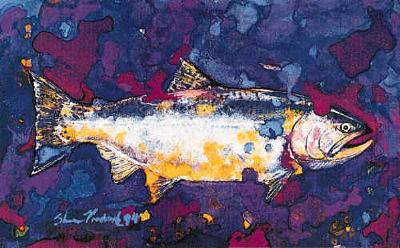|
|
Prayers Offered Salmon Before Run to Pacific
Tribe releases hatchery fish to supplement wild chinook stocks
by Rocky Barker-The Idaho Statesman
 YELLOWPINE,
Idaho _ Chuck Axtell's ancient song rang through the Johnson Creek canyon, a prayer of strength for thousands of
4-inch chinook salmon starting their 800-mile journey to the Pacific. YELLOWPINE,
Idaho _ Chuck Axtell's ancient song rang through the Johnson Creek canyon, a prayer of strength for thousands of
4-inch chinook salmon starting their 800-mile journey to the Pacific.As his traditional Nez Perce chant reached its crescendo, the clouds parted, bathing the holy man in sunlight as an eagle added its screeching voice to the harmony. The endangered chinook salmon, raised in the McCall National Hatchery, were returned to the native water of their parents by a fisheries team of the Nez Perce Tribe. Axtell's blessing was an expression of hope these fish will become a lifeline that preserves the unique characteristics that keep salmon returning to Johnson Creek and Idaho. "The significance of what we are doing is that we are sending our voices, our energy and our commitment with the salmon," said Silas Whitman, the Nez Perce fisheries manager. The tribal team recently released 80,000 of the 18-month-old chinook into the Salmon River tributary 100 miles northeast of Boise. They are the offspring of 54 wild salmon captured in 1998 -- a quarter of the salmon that returned to Johnson Creek that year. In 1960, about 1,000 salmon returned to spawn in Johnson Creek. In 1995, fewer than 15 came home. If all goes right, 80 to 200 of the progeny of the chinook the Nez Perce released will return during the next three years. The project is one of the last-ditch efforts agencies across the region are trying to prevent the salmon from going extinct. "Our goal is not to save the fish," said Jason Vogel, a research biologist with the Nez Perce Tribe. "We want to sustain the population long enough so that more drastic measures can be taken." The project is controversial because taking salmon out of the wild and placing them in hatcheries is one of the root causes of the fish's decline in the Pacific Northwest. These domesticated salmon adapt to hatchery conditions instead of the rigors of the harsh natural environment. When mixed with wild stocks, hatchery salmon reduce the genetic diversity of the wild salmon, making them less productive, said Tim Burton, a fisheries biologist with the U.S. Forest Service. The Forest Service initially challenged the project. Only four percent of the salmon's historic range contains wild strains or stocks of salmon. Only 15 percent of the remaining range has wild salmon. The Middle Fork of the Salmon River is the largest basin where hatchery salmon were never introduced. "If we continue to put hatchery stocks on wild stocks, we won't have any wild salmon left," Burton said. But the Johnson Creek salmon were only raised from egg to juvenile in the hatchery and only for one generation. This minimal intervention reduces the genetic risk, said John Gebhards, the project leader. His team convinced the National Marine Fisheries Service that the risk of the wild salmon disappearing without intervention outweighs the long-term genetic risk. Tribal fisheries managers across the Pacific Northwest, including Whitman, have embraced the use of hatcheries to jump-start salmon recovery. Projects such as Johnson Creek are designed to increase the knowledge base to determine how extensively the practice can be used. Whitman considers salmon "supplementation" necessary because human activities -- dam-building, logging, mining and pollution -- have broken the circle of life. "Whenever we take something out of life, we have to give back something of equal value," Whitman said. The salmon hold special significance for the Nez Perce and other followers of the Seven Drum religion, Axtell said. Each Sunday, salmon is served first, then elk and then berries, indicative of the importance of salmon as a food source. This continuing connection makes restoring salmon a sacred duty handed down from parents and passed on to children, Whitman said, not only for the Nez Perce but for all in the Pacific Northwest. "If we don't protect the circle of life the salmon occupy, they will disappear," Whitman said. "Eventually, we will, too." |

 PORTLAND
_ Columbia River treaty tribes are ready to sell spring chinook salmon for the first time since 1977 because of
one of the best fish runs in decades.
PORTLAND
_ Columbia River treaty tribes are ready to sell spring chinook salmon for the first time since 1977 because of
one of the best fish runs in decades.